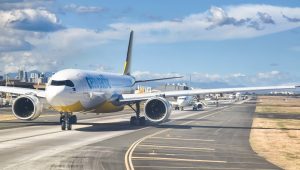Philippine airline Cebu Pacific recently announced that it had signed a binding Memorandum of Understanding with Airbus to purchase up to 152 aircraft. The deal at current prices has a potential value of $24 billion. Cebu has seen rapid growth in recent years, with the fleet increasing from 72 to 85 aircraft between 2022 and 2023. In the first half of 2024 alone, Cebu took delivery of seven more planes. The deal with Airbus, which is expected to be finalized later this year, would accelerate this expansion.
Cebu has been operating since the 1990s, and specializes in super-low airfares. By 2023, Cebu controlled about 53 percent of the Philippines’ domestic market, making it the largest airline in the country by passenger volume. The company’s strategy is simple and appealing to local consumers: focus on no-frills flights at affordable prices. Its aircraft are often modified in ways that maximize efficiency, for instance by removing toilets in order to increase passenger capacity.
This can be seen in a clip from travel vlogger Noel Philips who flew Cebu Pacific from Manila to Bangkok on an Airbus A330. The A330 is typically configured to carry about 300 people, but by removing most of the toilets, galleys, and other amenities Cebu could put 460 people on the flight. It’s not the most comfortable way to fly, but it is affordable. It also means operating the flight is cheaper on a per passenger basis, which is the entire business model of a low-cost airline.
Aside from a small fleet of ATR 72-600 turboprop airplanes that provide regional services, Cebu only operates Airbus aircraft. The MOU with Airbus is for a firm order of 102 A321s, with an option for an additional 50 aircraft in the A320 family. These are long, narrow-body airplanes meant for short and medium-range flights. It seems clear that Cebu plans to double (triple?) down on its strategy of focusing on low-fare, no-frills, densely packed domestic and regional flights using a fleet of aircraft it is familiar with and which can be operated at low cost.
Nevertheless, an order for this many aircraft will come with a steep price tag. We don’t know if $24 billion is really what it will cost, and aircraft production has a long lead time meaning Cebu will be receiving, paying for and financing these planes over a long time horizon. But certainly, acquiring this many new aircraft will cost many billions of dollars, which shows just how much faith the airline has in the domestic market, as well as its ability to dominate that market into the future.
Like many other countries in the region, 2019 was a high-water mark for tourism and air travel in the Philippines, with 60 million people flying domestically and internationally. Then, like every other airline in the world, Cebu was hit hard by the pandemic and booked three consecutive years of losses. 2023 was the first year since the COVID-19 pandemic when the carrier returned to profitability, recording net income of $135 million (using current exchange rates). The company’s equity, which was negative in 2022, came in at $82 million last year. This means assets exceeded liabilities, but only by a very thin margin.
Typically, a company with that kind of balance sheet might be hesitant to take on billions of dollars in new debt to expand the fleet. But tourism in the region is on the rebound. And while international arrivals to the Philippines have been a bit slower to recover than in some neighboring countries, domestic air travel in 2023 was just 2 percent lower than in 2019. In 2024, domestic passenger traffic is projected to exceed the 2019 figure and Cebu does not want to be caught flat-footed.
Clearly, the airline believes demand for affordable flights will continue growing at a rapid pace, and it wants to have sufficient capacity to maintain its market-leader position. This deal with Airbus thus represents a strong bet on two things. One, the purchasing power of the domestic consumer class will continue rising into the 2030s. And two, Filipinos with disposable income will, above all, appreciate the value of a good deal when buying airline tickets.

































